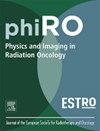螺旋放射治疗生产厂家综合质量控制的准确性
IF 3.3
Q2 ONCOLOGY
引用次数: 0
摘要
背景和目的制造商集成质量控制(MIQC)系统通常用于螺旋放射治疗,但在操作规程(COP)中不被认为是标准,如TG148/306或NCS27。MIQC可能导致假阳性结果,通常缺乏外部验证。能源质量控制(QC)条件在cop、手册或MIQC中定义,使用不同的场大小、幻象和指标,假设对能量变化具有相同的响应函数。本研究探讨了MIQC在螺旋放射治疗中的准确性。材料与方法对临床螺旋治疗单元进行能量、剂量率、场宽、气压等方面的调谐。对MIQC、传统QC方法和患者特异性质量保证的重现性/精密度和响应性/真实性进行评估。通过蒙特卡罗计算确定不同视场大小和不同幻像的深度剂量比DD10/1.5、DD20/1.5、DD20/10、组织幻像比TPR20/10和最大DD10之比(x)的响应差异。结果确定了MIQC诊断病因的准确性;精度通常很好,但准确性需要比例校正:例如,在大多数情况下,1% DD10(x, 5 × 10 cm2, H2O)对TPR20/10, DD20/10和出口检测器平整度的响应几乎相同,但2% DD20/1.5(1x40cm2)和阶梯楔形MIQC响应。出口检测器输出常数对场大小变化不敏感,但对能量和剂量率敏感。建立了包含响应函数和重现系数的导向表。结论MIQC计量准确度评估可用于确定cop的作用/容限,并可方便地分析常规实践中的越界结果。本文章由计算机程序翻译,如有差异,请以英文原文为准。
Accuracy of manufacturer integrated quality control for helical radiotherapy
Background and Purpose
Manufacturer-integrated quality control (MIQC) systems are often used but not considered standard in codes-of-practice (COP), such as TG148/306 or NCS27, for helical radiotherapy. MIQC can lead to false positive results and generally lacks external validation. Energy quality control (QC) conditions are defined in COPs, manuals, or MIQC using various field sizes, phantoms, and indicators assuming equal response functions to energy changes. This study investigated the accuracy of MIQC for helical radiotherapy.
Materials and Methods
A clinical helical treatment unit was detuned in terms of energy, dose rate, field width, and air pressure. The reproducibility/precision and response/trueness of MIQC, conventional QC methods, and patient-specific quality assurance were evaluated. Monte Carlo calculations were performed to identify differences in responses of depth dose ratios DD10/1.5, DD20/1.5, DD20/10, Tissue-Phantom Ratio TPR20/10, and ratio to max DD10(x) for various field sizes and phantoms.
Results
The accuracy of MIQC for underlying causes was determined; precision was often excellent, but trueness required proportionality correction: e.g., 1 % DD10(x, 5 × 10 cm2, H2O) showed almost equal response to TPR20/10, DD20/10 and exit detector flatness in most conditions but a 2 % DD20/1.5(1x40cm2) and step-wedge MIQC response. Exit detector output constancy was not significantly sensitive to field size changes but was sensitive to energy and dose rates. A guiding table containing response functions and reproducibility coefficients was established.
Conclusions
The MIQC metrological accuracy assessment can be used to define action/tolerance limits for COPs as well as to easily analyze out-of-bound results in routine practice.
求助全文
通过发布文献求助,成功后即可免费获取论文全文。
去求助
来源期刊

Physics and Imaging in Radiation Oncology
Physics and Astronomy-Radiation
CiteScore
5.30
自引率
18.90%
发文量
93
审稿时长
6 weeks
 求助内容:
求助内容: 应助结果提醒方式:
应助结果提醒方式:


